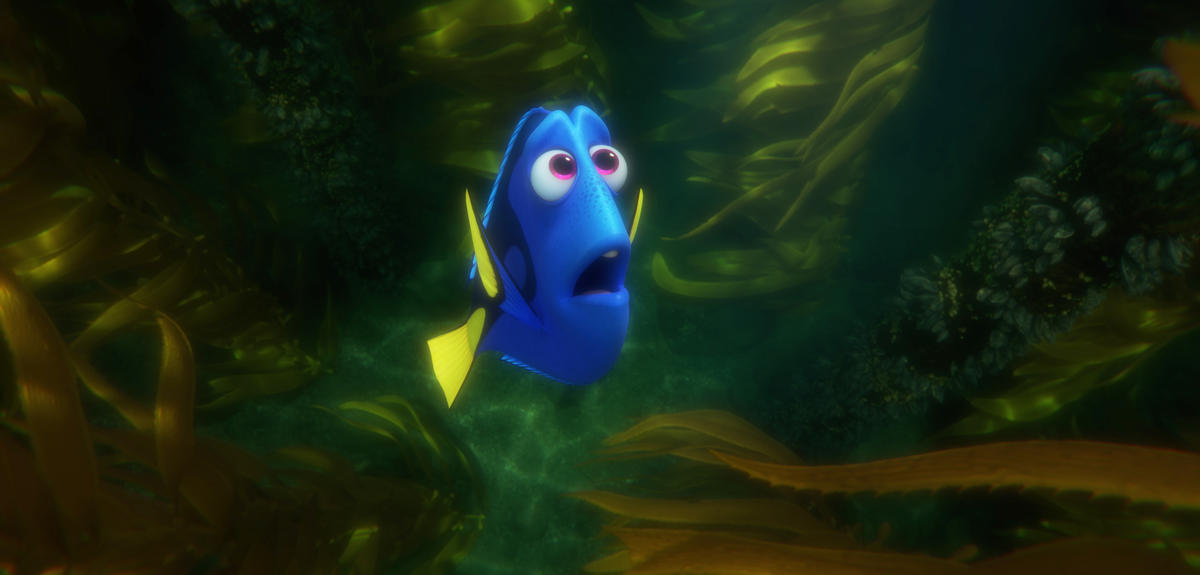You are here
Whatever Happened to Baby Dory?

Films like Spellbound (1945), Memento (2000), Mulholland Drive (2001), The Man Without a Past (2002) and Eternal Sunshine of the Spotless Mind (2004), are proof that memory problems are a recipe for success at the movies. Science fiction screenwriters know the narrative strength of storylines where one can erase the memories of a bothersome witness or of unhappy lovers. Just as fanciful (but nevertheless a subject of research) the implantation of false memories was particularly useful in Total Recall (1990) and Inception (2010). In contrast to these high-tech visions where memory is just a digital object with files that can be written and deleted at will, other films take a more realistic approach, doubtlessly based on medical facts about different types of amnesia. Among these, Dory, the blue tang fish who already featured in Finding Nemo (2003), is one of the most touching. Contrary to popular belief though, Dory has no problem with her short-term memory. This makes her just like the tattooed hero of Memento and patient “H.M.”, famous in the annals of neuropsychology. Pascale Piolino, head of the LMC laboratory,1 helped us establish a diagnosis for Dory by delving into the complexities of the different types of memory and the reconstruction of souvenirs, which can sometimes be shamelessly falsified by our malfunctioning brain.
In a flashback, we see Dory as a baby babbling that she “suffers from short-term memory loss.” This phrase, which is repeated throughout the movie, strikes you as inappropriate…
Pascale Piolino: It’s the only thing in the film that doesn’t ring true about this otherwise very coherent amnesic character. The “short-term memory” she refers to is the memory of the present. It allows us to remember information for a few seconds, before forgetting most of it. This includes memorizing figures until writing them down, or remembering the words that have just been spoken so as to follow a conversation. Now, these things are not a problem for Dory.
But she does often lose track of conversations, which is one of the comic traits of her character!
P.P.: Yes, she loses her train of thought, or even her way when she’s distracted. But, apart from that, she is able to hold a conversation for several minutes, whereas patients with short-term memory problems cannot repeat a sentence or a short series of figures they have just heard, even without being distracted. It is generally accepted that our short-term memory allows us to recall “7 items, plus or minus 2FermerBetween 5 and 9 items: this is the number of things that we are able to recall for a few seconds. However, a series of seven elements (8, 3, 5, 2, 1, 9, 4) can also read (835, 219, 4), thus giving us the possibility to remember four more. Mnemonic techniques therefore enable us to expand the capacities of the short-term memory.,” also referred to as “the magical number seven.” 2
Even though it would have been counterintuitive for the film audience to refer to long-term memory, is this Dory’s real problem?
P.P.: Exactly. One needs to understand that the storage range of long-term memory is very broad—between one minute and a lifetime. It is clear that Dory has problems: she records information for a few seconds or minutes, but gradually forgets if she gets distracted.
Dory resembles Shelby (Guy Pearce), the hero of Memento. In one scene of this film, after an argument with Natalie (Carrie-Ann Moss), who he knows is lying, Shelby wants to write things down and searches desperately for a pen that she has hidden, before she slams the door to make him lose his train of thought.
P.P.: This is true. Dory also resembles the famous "Patient H.M."FermerThe pseudonym of Henry Gustav Molaison, an American who, in 1953, had his medial temporal lobes, including the hippocampus, removed. The operation was effective against his epileptic fits, which did not respond to medication. However, it also gave him anterograde amnesia and retrograde amnesia concerning several years of his past, while his short-term memory remained unharmed. He could play chess or follow a conversation, but any distraction would cause him to lose the thread. All three suffer from anterograde amnesiaFermerIncapacity to memorize everyday events over time, following a trauma (psychological shock or brain damage, notably to the hippocampus). However, these patients do remember the past before the trauma.: they are incapable of memorizing new information for longer than a few minutes. This usually follows a physical or psychological brain trauma, such as the removal of the medial temporal lobes, including the hippocampusFermerSmall structure in the brain essential for long-term memory, in particular episodic memory. It belongs to the limbic system and is located in the medial temporal lobe., in the case of “patient H.M.” For Shelby, it was his wife’s murder coupled with a knock on the head during the attack, although his case is more complex and we’ll come back to it… For Dory, the original trauma is not revealed in the film. It appears to date back to early childhood since, in the flashback that you mention, we see her as a baby and already amnesic, hence the absence of a past: she progressively forgets things and almost always has.
Are there patients who have had anterograde amnesia from birth, as seems to be the case with Dory?
P.P.: Yes. Dory immediately makes me think of developmental amnesia. This condition affects children who have suffered an injury to the hippocampus due to a medication incident, a tumor, or lack of oxygen to the brain at birth (neonatal anoxia) caused by the umbilical cord, for example. These children develop a bit like Dory: while they are incapable of memorizing episodes of their lives, they follow a relatively normal education, are intelligent, and can reason and acquire knowledge. Family and teachers use strategies of repetition, making them read the same book twenty times for example, exactly like baby Dory’s parents keep telling her that the shells mark the way home.
How can Dory or these children retain any knowledge when everything is erased after two minutes?
P.P.: In actual fact, not everything is erased, only the memories associated with context, everyday life and episodes of their lives. This is known as episodic memory. It is just one part of long-term memory, which also includes procedural memory (automatisms like the series of actions required to walk, talk, swim, etc.) and semantic memory (general and cultural information such as names and definitions that are not linked to a particular context). These various memories are linked to different parts of the brain. For the episodic memory, it is mainly the hippocampus that makes it possible to record information, and this is done in a manner closely related to the context in which it has been learnt. The hippocampus appears to be Dory’s real weak point… Thankfully, repeating things over and over again makes it possible to bring into use the neuron networks of other regions of the brain, those assigned to automatic and semantic tasks. Thanks to these highly methodic processes, Dory knows who she is, doesn’t forget how to swim, knows whale language without remembering how she learnt it and is aware that Nemo and Marlin, the clown fish, are important in her life, even if she doesn’t remember the experiences she shared with them.

Dory has “flashbacks” of certain episodes of her past life. Doesn’t this mean that she does have an episodic memory?
P.P.: These mental images represent a form of episodic memory, albeit very poor. Episodic memory is not a narrative that is recorded like a film and subsequently remains unchanged. It is constantly reconstructed from fragments of information present in the brain. This could also explain what we call false memories: during these reconstructions, it is possible that certain pieces of the puzzle that have become blurred may be replaced with newer and clearer elements of one’s life. Dory seems to have a deficiency in the reconstruction or consolidation of her episodic memory. There again, the hippocampus plays a key role. After the initial recording of the situation, which corresponds to the way in which the stimuli activated different brain zones, it “replays” this pattern to bring back a memory. There are variants in today’s theories though. The screenwriters seem to have chosen a model in which the hippocampus remains the key to consolidating memories, whether old or recent .
To summarize, “I consolidate, therefore I am”…
P.P.: Yes, because we don’t consolidate all our memories; it’s healthy to forget! The selection gets made according to our interests, tastes, environment, etc. It differs from one person to the next even if they experience exactly the same events. This is the foundation of our individual identities.
When does this consolidation of memories occur? The role of sleep is often mentioned, as in the results3 obtained by Michaël Zugaro’s team at the CIRB4…
P.P.: Consolidation takes place continually; it is an update of long-term memory. A memory can be updated in an hour, during several years or over a lifetime. It works by rethinking about things and talking about them, as well indeed as during sleep. The results you mention underline the important role the hippocampus plays for consolidation while we sleep.
In the film, the link between memory and emotions is strongly emphasized. What do you think?
P.P.: This is finely observed. The flashbacks mostly concern Dory’s parents. It makes sense that she should be capable of recording those memories more precisely because of the emotions associated with them. Emotions put different cerebral regions to work, such as the amygdala, which allows a deeper recording.
I’ve seen diagrams where memories are first “recorded” in the short-term memory, before being “transferred”—after filtering—into the long-term memory.
P.P.: This is a particularly old conception! In today’s models, short-term and long-term memory are not two boxes connected in series: there’s no need to go through one to get to the other. There are parallel entry points. This explains cases like patient “K.F.”,5 who had great long-term learning capacity despite a highly damaged short-term memory. In short, long-term memory, which updates itself constantly, includes several types of memories (episodic, semantic, procedural, etc.) that call upon different regions of the brain.6 The efficiency and role of all these structures and processes, which we all have, vary in part between individuals. Everyone optimizes this by relying on their strong points: some people remember circumstances best, others names, etc.
If Dory and Shelby, the hero of Memento, have the same amnesia, why can’t he remember who he is?
P.P.: While Shelby definitely has anterograde amnesia like Dory, he also has retrograde amnesiaFermerPartial or total loss of memory of events that took place before a trauma or prior to the start of the condition affecting the patients who keep their semantic (general knowledge) and procedural (automatisms such as knowing how to drive, ride a bicycle or play a musical instrument) memory. of all the episodes of his life preceding the attack on his wife—hence his identity amnesia. In these cases, which are thankfully very rare, patients build another identity according to the new events they live though. They can change tastes, affinities with people, etc.
This is the theme of The Man Without a Past by Aki Kaurismäki. The hero is robbed and beaten. When he regains consciousness, he has amnesia. With no money or identity, he is helped by the homeless. When his family and friends find him, he doesn’t want to go home…
P.P.: That’s it. These cases are very disturbing and much debated. As in the film, the patients suffered a trauma (brain injury or psychological shock) or a great deal of stress. But is this the only cause of their amnesia? Might they not have decided unconsciously not to remember?
(Spoiler warning for the film Memento)
Doesn’t this question also apply to Shelby, the hero of Memento?
P.P.: Yes indeed. We can suppose that he killed his wife through jealousy and preferred not to remember this, replacing it by an imagined situation—an attack by a third party—that was plausible and acceptable for his sense of identity. One can think that these memories have not been erased but that his brain won’t give him access to them. This is the case with most cases of amnesia. Some patients can later regain their memory. It is only erased permanently if there is an injury that physically destroys parts of the brain and neuron networks, as in Alzheimer’s disease.
Is Dory’s amnesia incurable?
P.P.: The most likely possibility is that she has an injury to the hippocampus. Some disorders of this type can be temporary—while a certain drug is being taken, in case of transitory stress or after having drunk too much, for example. But I'm afraid that with Dory, the damage is permanent if she suffered an irreversible lesion to the hippocampus at birth, in the same way as the children I mentioned at the start of the interview. Yet, like them, she does quite well. She is resourceful and intelligent (Editor’s Note: When Marlin and Nemo find themselves in a tricky situation, they ask themselves “What would Dory do?”). And, most of all, she is happy.
- 1. Laboratoire mémoire et cognition (Université Sorbonne Paris Cité / Université Paris Descartes / Inserm / Centre hospitalier Sainte-Anne).
- 2. After the famous article by G. A. Miller, “The magical number seven, plus or minus two: Some limits on our capacity for processing information”, Psychological Review, 1956.
- 3. http://www2.cnrs.fr/en/2757.htm
- 4. Centre interdisciplinaire de recherche en biologie (CNRS / Inserm / Collège de France).
- 5. Described by Shallice and Warrington (1970).
- 6. In French: http://www.inserm.fr/thematiques/neurosciences-sciences-cognitives-neuro...








